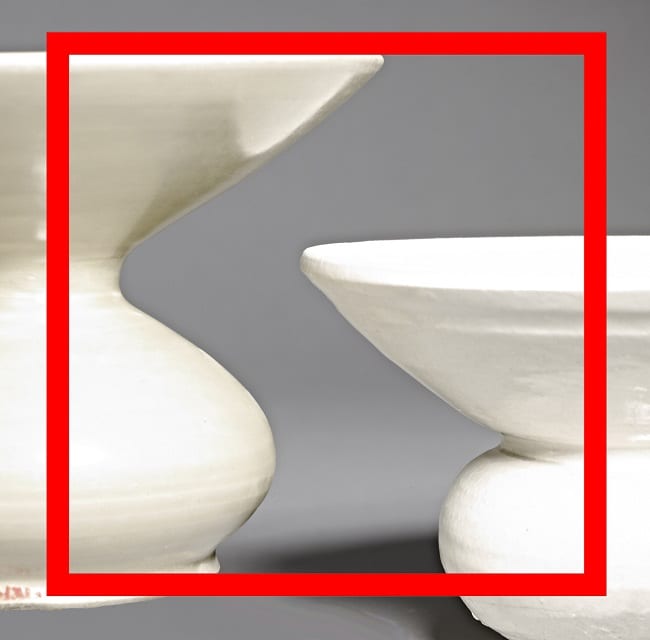As part of the exciting reinstallation of their Chinese ceramics galleries, the Philadelphia Museum of Art is exhibiting four of Eric Zetterquist’s Object Portraits that have been acquired for the permanent collection. For over a thousand years the Chinese have painted portraits of art objects in their collections, both to extol the esthetic virtues of an object and to exhibit the accomplishments of a collector. Following and contemporizing this practice, Eric Zetterquist, a specialist in Asian ceramics and CFile’s New York editor, has created a series of portraits of ceramics: Tang Dynasty (618 – 907 A.D.), Song Dynasty (960 – 1279 A.D.), and Yuan Dynasty (1279 – 1368 A.D.).
He has done this by isolating minute form elements of the object, and highlighting the negative space created by them. He further reduces and abstracts these forms by creating large-scale, flattened images in black and white with “painterly” edges.
Unlike the hard-edged minimalism of the seventies, the splashed edges, together with the matte-textured paper on which they are printed, are evocative of Asian calligraphy, and create “warm minimalist” abstractions. Not merely photographs of objects, these works compel their viewers to see and contemplate form in a new way.
Why minimalism? Although it is folly to ascribe modern “isms” to ancient minds, the makers of Song Dynasty ceramics, then the highest medium for secular sculpture, intentionally addressed the concept of minimalism a thousand years ago. Influenced by Chan (Zen) Buddhism, the Song Dynasty literati intentionally subscribed to the “less is more” esthetic. They had the technology to decorate ceramics, but chose to leave them monochromatic and let the strength of their forms speak for themselves.
Every work of art should reveal the sum total of the artist’s life experience. During his time as a collector, dealer and photographer of the ceramics of this period, Zetterquist has given thought as to what makes a form dynamic, and how we perceive this dynamism, either consciously or subconsciously.
These large modern images of ancient objects result from his connoisseurship and artistic visions. The photographs below show the ceramic that is the subject, a red line frames the segment of each ceramic that he has extracted and then the resulting image together with his commentary on each work.
Above image: Detail image of 9th century cuspidors included in Zetterquist’s exhibition.
Any thoughts about this post? Share yours in the comment box below.


“Guan-Yao Cup (Southern Song Dynasty 1127 – 1279 A.D.): The shape of the handle comes from metal work cups imported into China during the Tang and Liao Dynasties. The origins of this form are Middle Eastern, and are often seen in architectural arches. I took this cue, blacking out the actual cup and handle and leaving the space above white, to try to recreate its architectural origins.”


“Pair of 9th century cuspidors: Sometimes the negative space between two objects can highlight the dynamism of their forms. In the case of these two objects, the blackened space between creates an exciting third form akin to a lightning bolt, or the twists and curves of a mature river.”


“Crackled Longquan-Guan Dish and Ribbed Jar (1127-1279): Although I am usually concerned with the lines of the form itself, in some cases, the “decoration” of the piece tells the story of the form in an exiting way. In the case of the crackle-glazed dish, the pattern of the crackle in the center is denser than that on the rim (due to different clay body thicknesses causing different cooling rates of the glaze that create the crackle). This difference in crackle density differentiates the form elements from each other, and the overall form itself.”


“In the case of the Ribbed Henan Jar (Jin Dynasty 960-1279), the decoration is of parallel vertical lines and “X” forms. The perspective of the “X” shapes and the diminishing spaces between the parallels tells the viewer that the form is rounded, without even showing the profile of the form. This illustrates the sort of learned, unconscious judgments we make about form without even realizing it.”



“Huanghuali Scholar’s Table: The elegant bead of decoration that follows the skirt and leg of this18th century table is reminiscent of a taotie mask, a motif that comes from classical antiquity and has been a constant of Chinese design since the bronze age. This simple flourish inextricably ties it to three thousand years of Chinese history and collective consciousness, underling the subliminal power of the form.”
Visit the Philadelphia Museum of Art

I love these images allowing me to see form in a different way; it also brings me to my Ikebana education “less is more” but here in those pictures it is not with flowers but forms.
Thank you